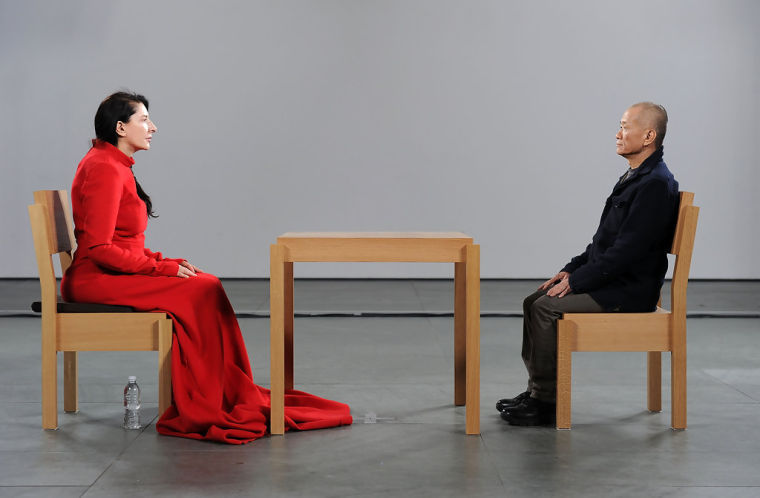
“The Artist is Present,” an exhibit at the Museum of Modern Art in 2010, featured Marina Abramović sitting in a chair, staring straight ahead.
“Don’t go to the top floor. There are naked people.”
Upon hearing these words, I immediately tore myself away from the abstract fruit painting I had been examining and, with a group of friends, bolted to the nearest elevator and up to the top floor of New York’s Museum of Modern Art.
And though we were still in the gleaming whiteness of MoMA, stepping out of that elevator felt like walking into somewhere foreign, alien, other. An old Soviet truck rested in front of the entrance to a gallery, its siren blaring a message in cold, garbled Russian. Barbed wire and bones and large tanks of blood — or what definitely looked like it — sat in front of a projection involving a woman beating herself with a skull.
And then, of course, there were the naked people.
The exhibition was 2010’s “The Artist Is Present,” a retrospective of the works of Marina Abramović. Though Abramović has been a respected performance artist, photographer and videographer for nearly half a century, she has had a pop resurgence of late, working with everyone from Lady Gaga to James Franco to Jay Z.
Indeed, Jay Z’s recent foray into performance art, Picasso Baby: A Performance Art Film, is classic Abramović: The rapper took hold of a gallery and repeatedly performed one piece of music (“Picasso Baby,” from this summer’s Magna Carta Holy Grail) for six continuous hours. Like Abramović’s best work, the piece dealt with issues of spectatorship, endurance, autonomy and defining — as well as breaking — the limits of the human body.
Those same themes were on display throughout “The Artist Is Present.” Grainy black-and-white videos projected onto the walls showed Abramović and her one-time partner, Ulay, performing horrific, hypnotic feats: One projection depicted the artists running full force into concrete pillars. Another featured an extreme close-up of a man and woman with their mouths taped together, sharing one breath, rhythmically pushing a single gulp of air back and forth.
In yet another piece, the famous “Rest Energy,” Ulay draws back the string of a bow, with the arrow pointed directly at Abramović’s heart. They balance each other, pulling against the other into a state of unsteady equilibrium. One falter or twitch, and Abramović could die. Watching the video repeat on the MoMA wall, it was impossible not to become lost in the riveting tension, the complex visualization of trust, support and the physical and emotional strain required of both.
Elsewhere in the exhibit, live performers recreated some of Abramović’s past performance pieces. One woman sat, nude, on a pedestal, lights cast on her to recreate Leonardo da Vinci’s Vitruvian Man. And in a gap between gallery rooms, two naked women stood, creating a human doorway that needed to be crossed.
But rather than an erotic experience, the act of passing between the women was nerve-racking, intense; the vulnerability of the women’s bodies was off-putting rather than tantalizing. Sidling awkwardly between the women, I became acutely aware of my own body and its strangeness. Power dynamics subtly shifted. Though the women stood passively and without emotion, they had all the control. Crossing that human boundary was a deeply unnerving but ultimately cathartic experience. I don’t mean to sound melodramatic, but it was like being reborn.
And that’s the real power of Abramović, who was, in fact, present at MoMA on that spring day in 2010. The centerpiece of the installation was just Abramović herself, cloaked in red and sitting at a desk in the center of a white, sterile room. Crowds gathered around the walls to stare as bold individuals (including, at various points, her old partner Ulay, James Franco and my friend Ricky) lined up and sat across from the artist, who simply sat, passively — yet decisively — gazing straight ahead.
In that performance, and throughout her entire body of work, Abramović plays with and contorts our notions of control: of herself, of her body and of her audience. That’s the trick and requirement of her art: She’s always in control.
A crowd gathered, watching one woman. One woman, watching.



